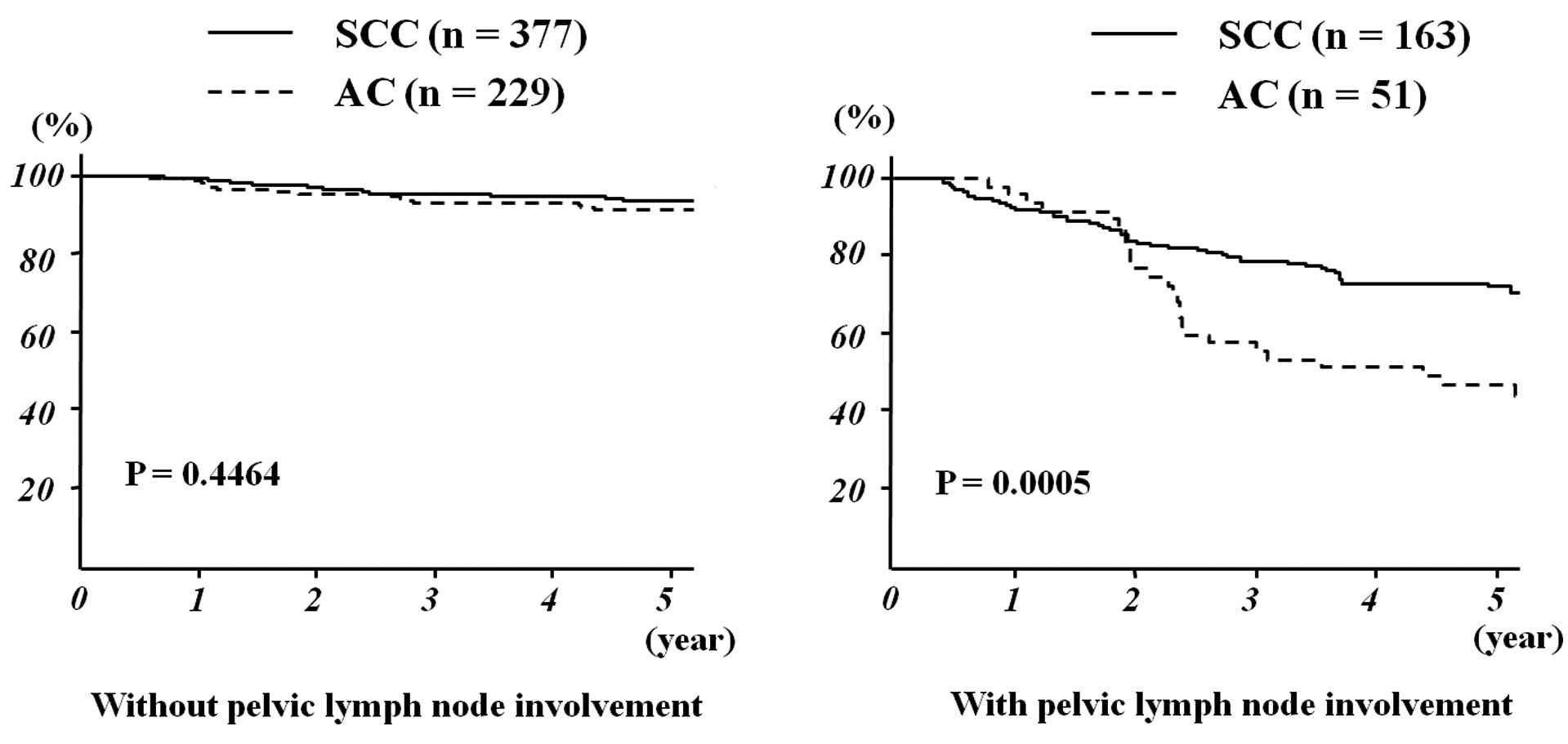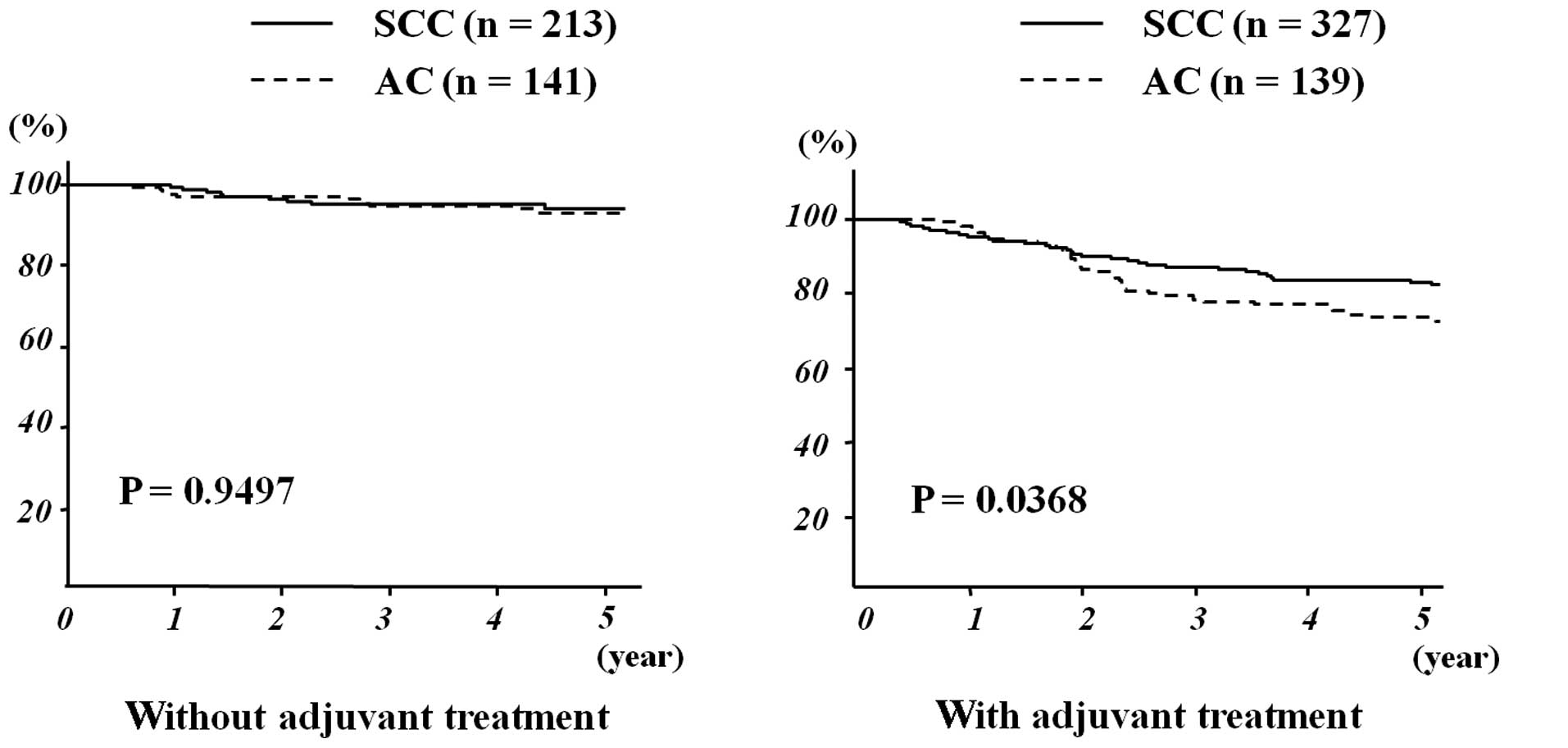|
1.
|
The annual report of the Japanese Society
of Obstetrics and Gynecology 2010. Acta Obstetricia Et Gynecologica
Japonica. 64:1029–1141. 2012.
|
|
2.
|
NCCN Clinical Practice Guidelines in
Oncology-cervical cancer v.1. 2011. National Comprehensive Cancer
Network (http://www.nccn.org/professionalsphysician_gls/f_guidelines.asp).
Accessed November 9, 2010.
|
|
3.
|
Sedlis A, Bundy BN, Rotman MZ, Lentz SS,
Muderspach LI and Zaino RJ: A randomized trial of pelvic radiation
therapy versus no further therapy in selected patients with stage
IB carcinoma of the cervix after radical hysterectomy and pelvic
lymphadenectomy: a Gynecologic Oncology Group Study. Gynecol Oncol.
73:177–183. 1999. View Article : Google Scholar
|
|
4.
|
Peters WA III, Liu PY, Barrett RJ II, et
al: Concurrent chemotherapy and pelvic radiation therapy compared
with pelvic radiation therapy alone as adjuvant therapy after
radical surgery in high-risk early-stage cancer of the cervix. J
Clin Oncol. 18:1606–1613. 2000.
|
|
5.
|
Smith HO, Tiffany MF, Qualls CR and Key
CR: The rising incidence of adenocarcinoma relative to squamous
cell carcinoma of the United States - a 24-year population-based
study. Gynecol Oncol. 78:97–105. 2000.
|
|
6.
|
Look KY, Brunetto VL, Clarke-Pearson DL,
et al: An analysis of cell type in patients with surgically staged
stage IB carcinoma of the cervix: a Gynecologic Oncology Group
Study. Gynecol Oncol. 63:304–311. 1996. View Article : Google Scholar : PubMed/NCBI
|
|
7.
|
Park JY, Kim DY, Kim JH, Kim YM, Kim YT
and Nam JH: Outcome after radical hysterectomy in patients with
early-stage adenocarcinoma of uterine cervix. Br J Cancer.
102:1692–1698. 2010. View Article : Google Scholar : PubMed/NCBI
|
|
8.
|
Shingleton HM, Bell MC, Fremgen A, et al:
Is there really a difference in survival of women with squamous
cell carcinoma, adenocarcinoma, and adenosquamous cell carcinoma of
the cervix? Cancer. 76:1948–1955. 1995. View Article : Google Scholar : PubMed/NCBI
|
|
9.
|
Kasamatsu T, Onda T, Sawada M, et al:
Radical hysterectomy for FIGO stage I-IIB adenocarcinoma of the
uterine cervix. Br J Cancer. 100:1400–1405. 2009. View Article : Google Scholar : PubMed/NCBI
|
|
10.
|
Chen RJ, Lin YH, Chen CA, Huang SC, Chow
SN and Hsieh CY: Influence of histologic type and age on survival
rates for invasive cervical carcinoma in Taiwan. Gynecol Oncol.
73:184–190. 1999. View Article : Google Scholar : PubMed/NCBI
|
|
11.
|
Shimada M, Kigawa J, Nishimura R, et al:
Ovarian metastasis in carcinoma of the uterine cervix. Gynecol
Oncol. 101:234–237. 2006. View Article : Google Scholar : PubMed/NCBI
|
|
12.
|
Irie T, Kigawa J, Minagawa Y, et al:
Prognosis and clinicopathological characteristics of Ib-IIb
adenocarcinoma of the uterine cervix in patients who have had
radical hysterectomy. Eur J Sur Oncol. 26:464–467. 2000. View Article : Google Scholar : PubMed/NCBI
|
|
13.
|
Landoni F, Maneo A, Colombo A, et al:
Randomised study of radical surgery versus radiotherapy for stage
Ib-IIa cervical cancer. Lancet. 350:535–540. 1997. View Article : Google Scholar : PubMed/NCBI
|
|
14.
|
Niibe Y, Kenjo M, Onishi H, et al:
High-dose-rate intracavitary brachytherapy combined with external
beam radiotherapy for stage IIIb adenocarcinoma of the uterine
cervix in Japan: a multi-institutional study of Japanese Society of
Therapeutic Radiology and Oncology 2006–2007 (study of JASTRO
2006–2007). Jpn J Clin Oncol. 40:795–799. 2010.PubMed/NCBI
|
|
15.
|
Baalbergen A, Ewing-Graham PC, Hop WC,
Struijk P and Helmerhorst TJ: Prognostic factors in adenocarcinoma
of the uterine cervix. Gynecol Oncol. 92:262–267. 2004. View Article : Google Scholar : PubMed/NCBI
|
|
16.
|
Eifel PJ, Burke TW, Morris M and Smith TL:
Adenocarcinoma as an independent risk factor for disease recurrence
in patients with stage IB cervical carcinoma. Gynecol Oncol.
59:38–44. 1995. View Article : Google Scholar : PubMed/NCBI
|
|
17.
|
Toita T, Sakumoto K, Higashi M, et al:
Therapeutic value of neoadjuvant intra-arterial chemotherapy
(cisplatin) and irradiation for locally advanced uterine cervical
cancer. Gynecol Oncol. 65:421–424. 1997. View Article : Google Scholar
|
|
18.
|
Hareyama M, Sakata K, Oouchi A, et al:
High-dose-rate versus low-dose-rate intracavitary therapy for
carcinoma of the uterine cervix: a randomized trial. Cancer.
94:117–124. 2002. View Article : Google Scholar : PubMed/NCBI
|
|
19.
|
Nakano T, Kato S, Ohno T, et al: Long-term
results of high-dose rate intracavitary brachytherapy for squamous
cell carcinoma of the uterine cervix. Cancer. 103:92–101. 2005.
View Article : Google Scholar : PubMed/NCBI
|
|
20.
|
Nakanishi T, Ishikawa H, Suzuki Y, Inoue
T, Nakamura S and Kuzuya K: A comparison of prognoses of pathologic
stage Ib adenocarcinoma and squamous cell carcinoma of the uterine
cervix. Gynecol Oncol. 79:289–293. 2000. View Article : Google Scholar : PubMed/NCBI
|
|
21.
|
Sakuragi N, Satoh C, Takeda N, et al:
Incidence and distribution pattern of pelvic and paraaortic lymph
node metastases in patients with stages Ib, IIa, and IIb cervical
carcinoma treated with radical hysterectomy. Cancer. 85:1547–1554.
1999. View Article : Google Scholar
|
|
22.
|
Takeshima N, Umayahara K, Fujiwara K, et
al: Treatment results of adjuvant chemotherapy after radical
hysterectomy for intermediate- and high-risk stage IB-IIA cervical
cancer. Gynecol Oncol. 103:618–622. 2006. View Article : Google Scholar : PubMed/NCBI
|
|
23.
|
Hosaka M, Watari H, Takeda M, et al:
Treatment of cervical cancer with adjuvant chemotherapy versus
adjuvant radiotherapy after radical hysterectomy and systematic
lymphadenectomy. J Obstet Gynaecol Res. 34:552–556. 2008.
View Article : Google Scholar
|











